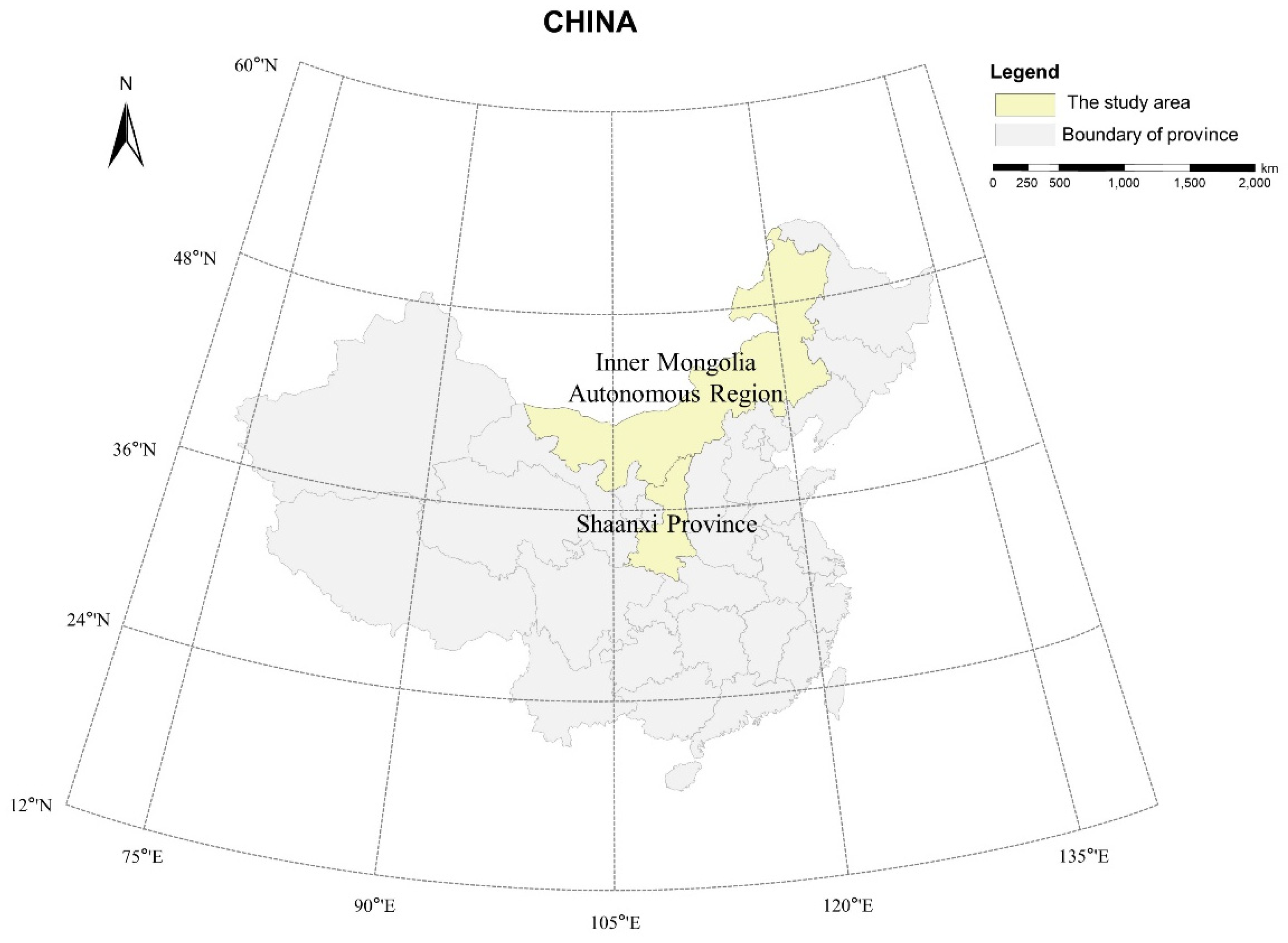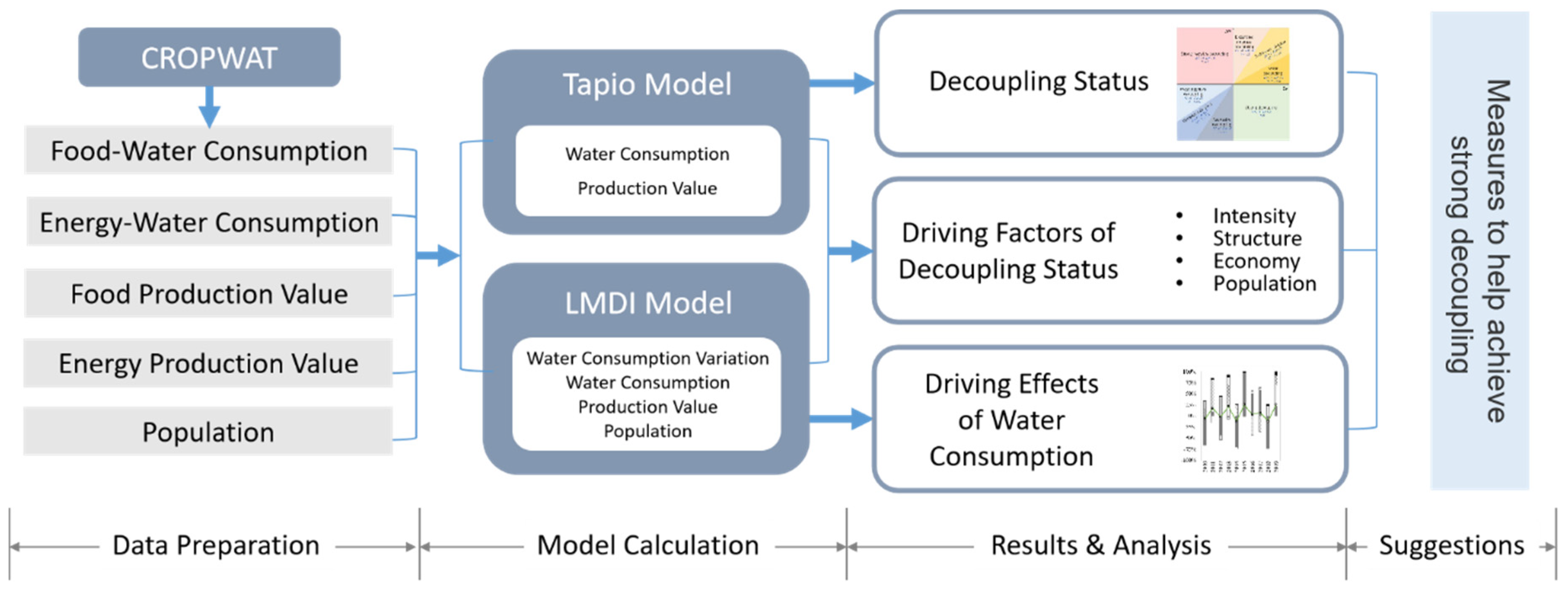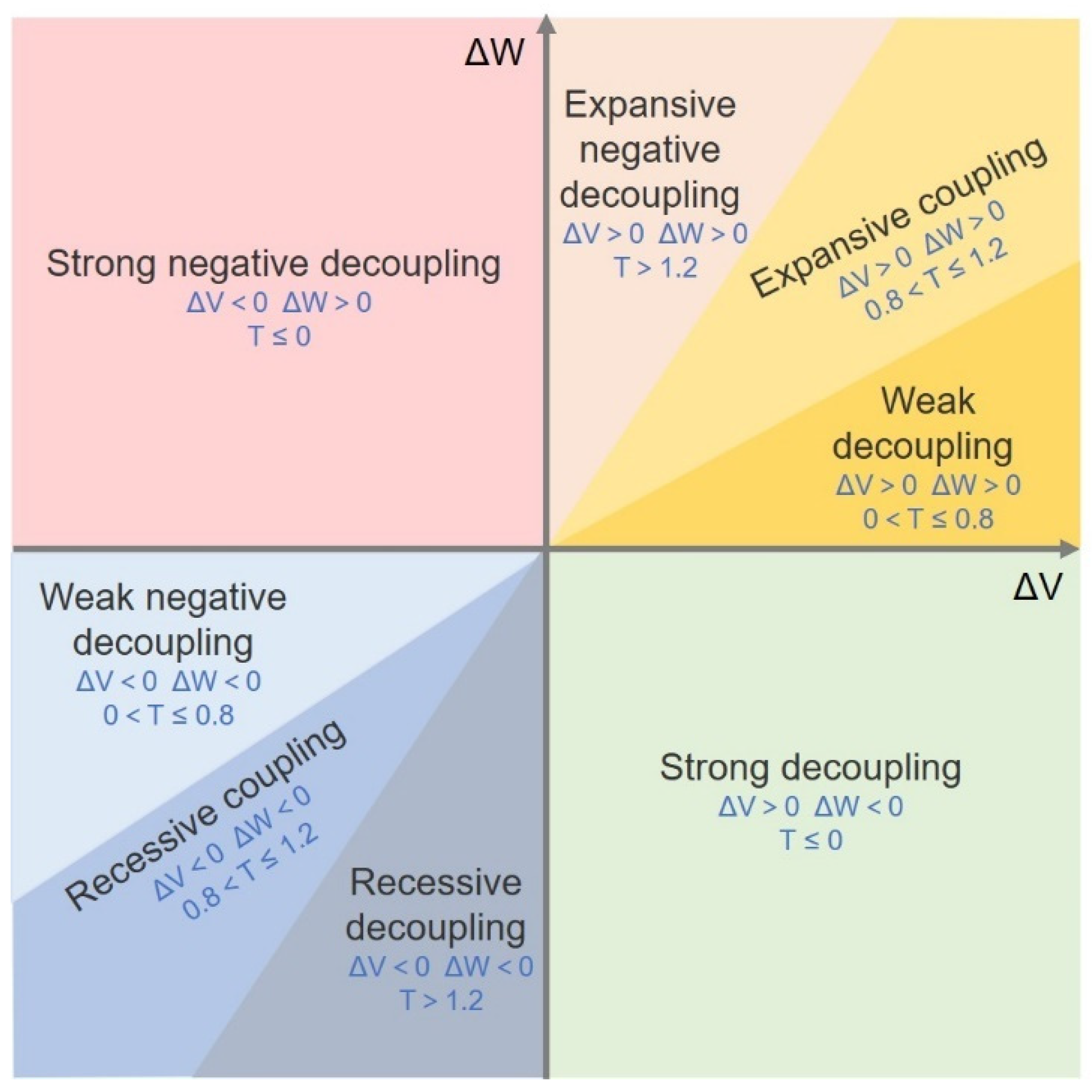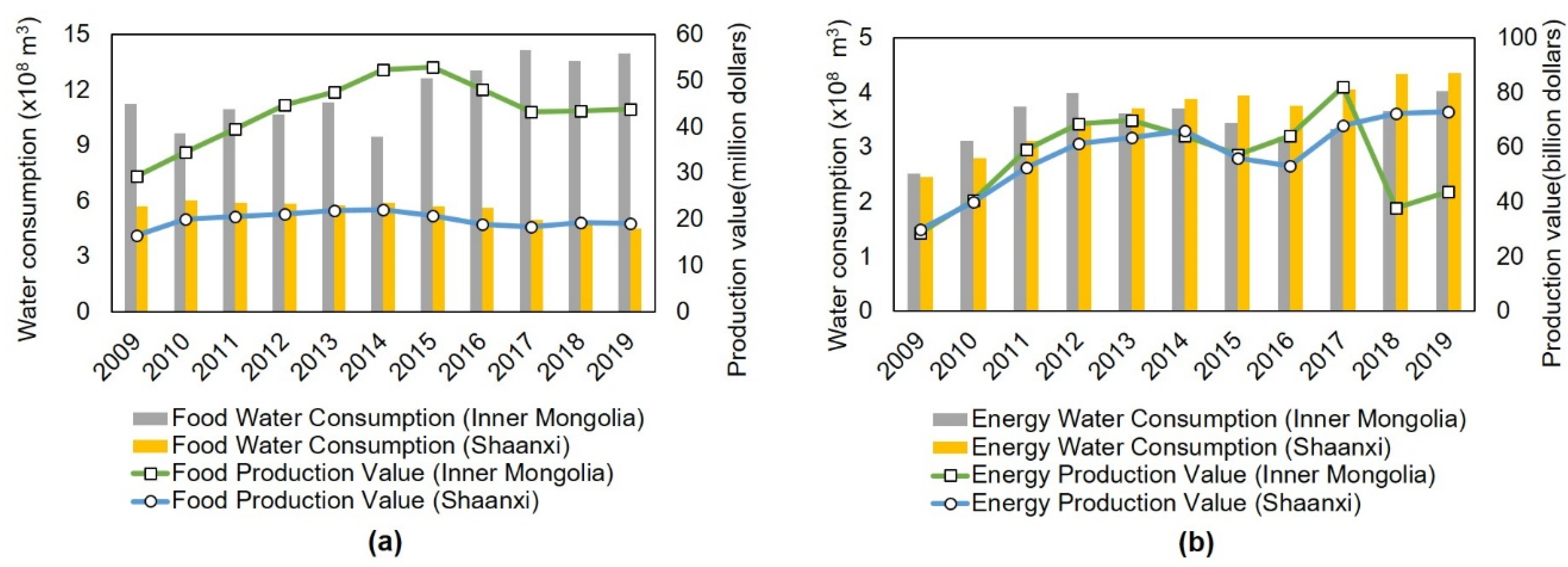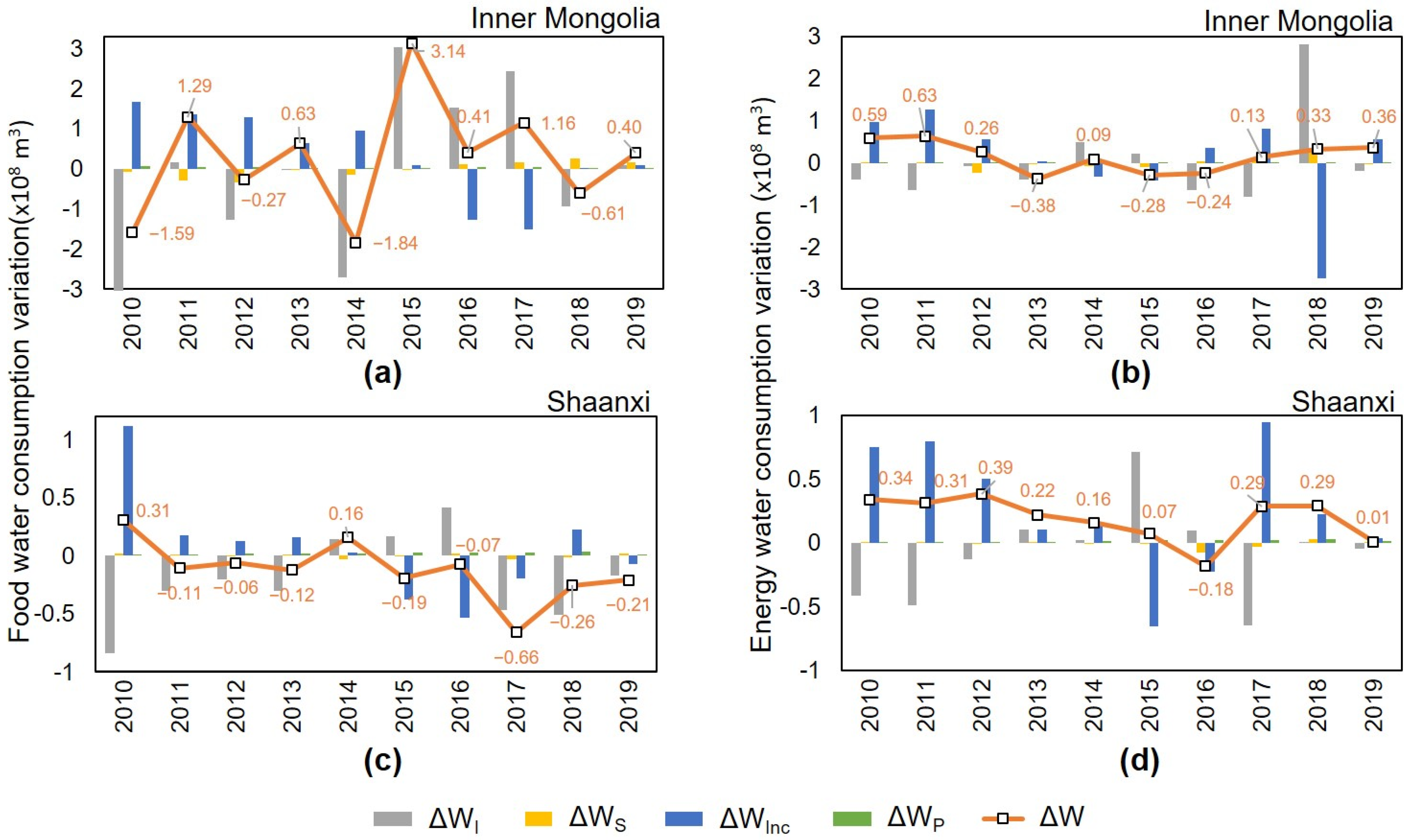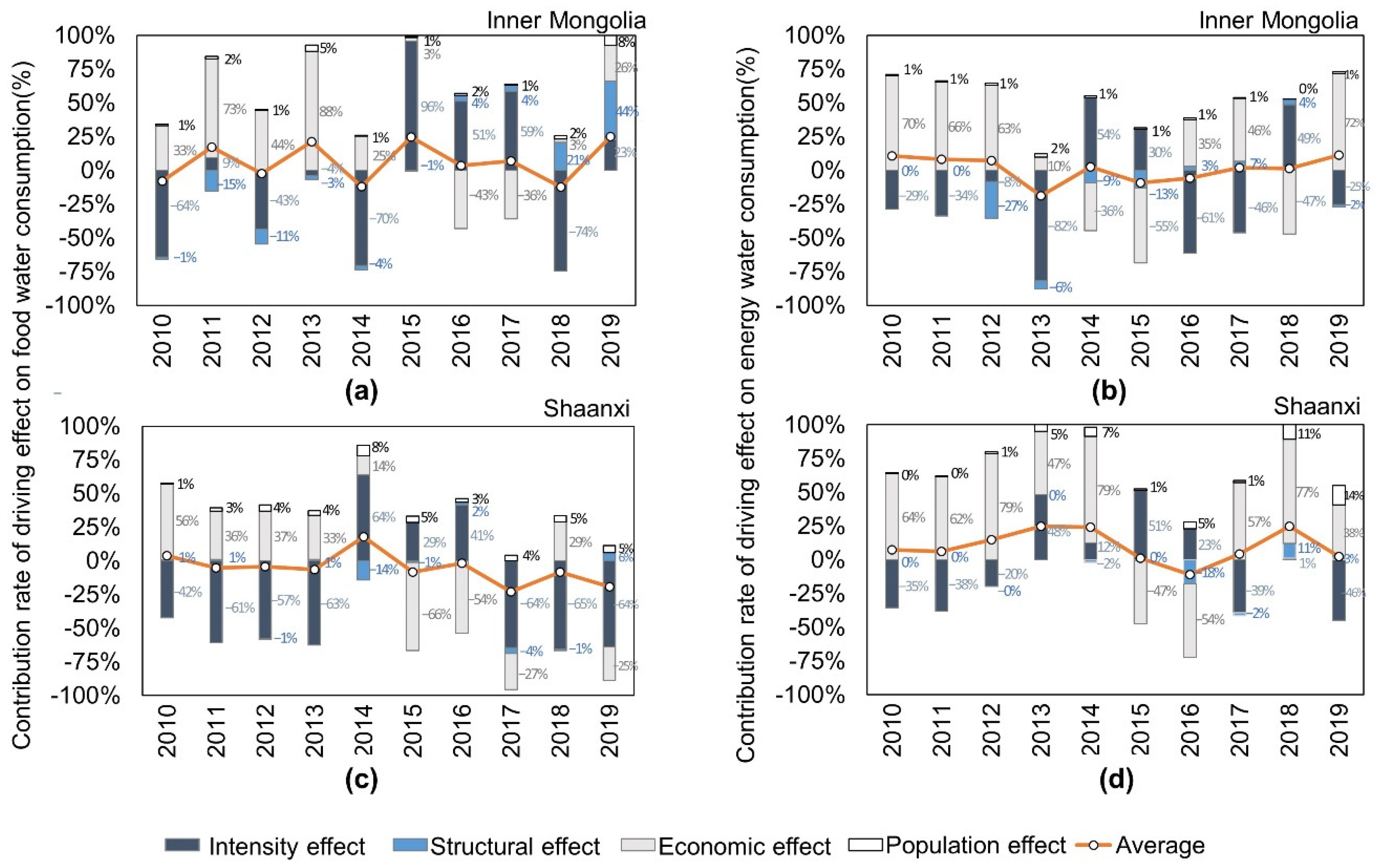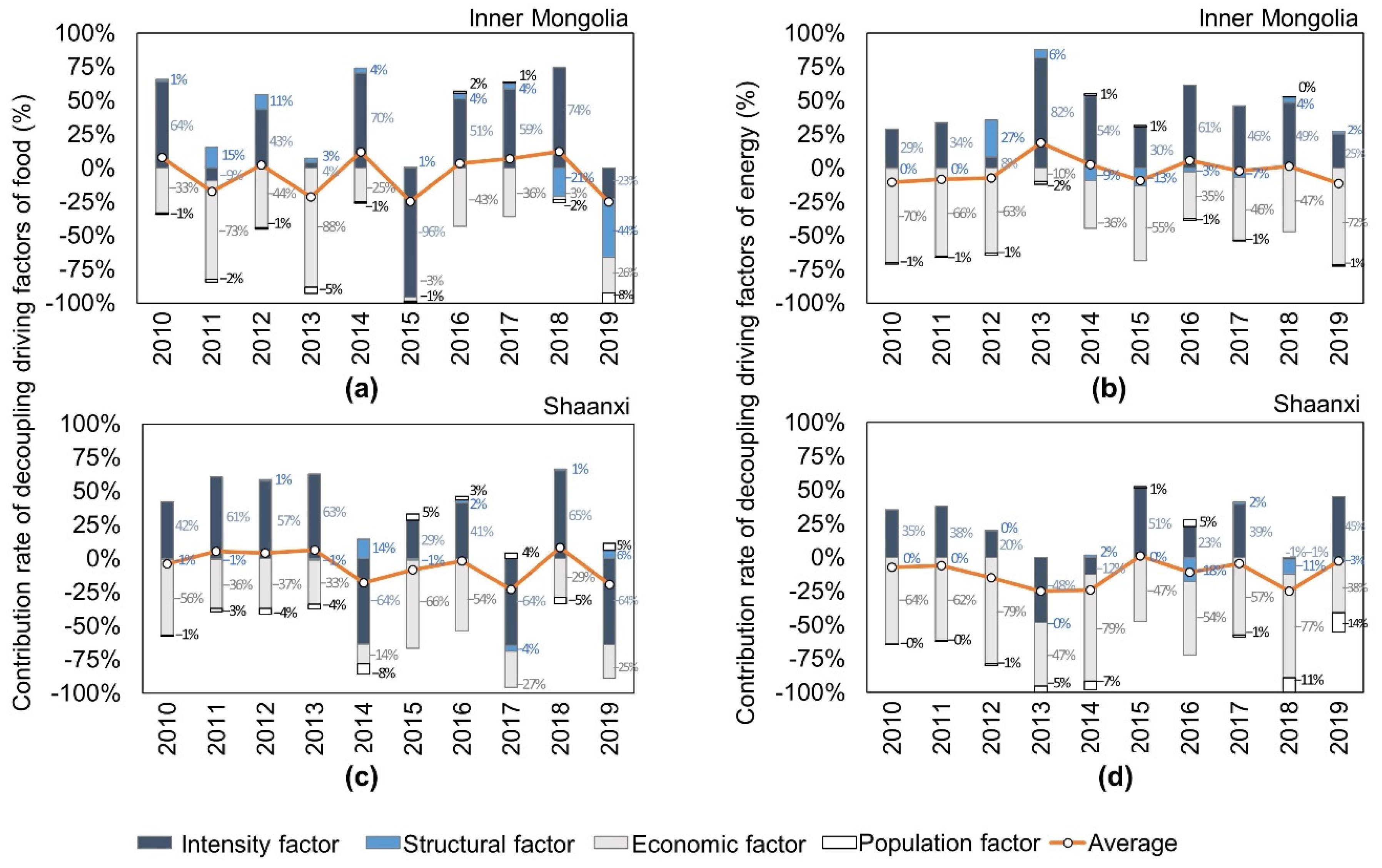1. Introduction
Water, energy, and food are the material basis for human society and economic development [
1]. The 2011
Global Risk Report notes the influence of the complicated relationship among water, energy, and food on regional sustainable development, and suggests that water resources are the most essential resources. Only balanced supply and demand of water resources in industries can ensure the stable supply of food and energy to realize the sustainable development of the economy and society [
2]. With the increasing demand for water resources, the contradiction between supply and demand of water resources is becoming increasingly prominent, and the sustainability of the economy and society is also facing significant challenges [
3].
“Decoupling” is a basic theory put forward by the Organization for Economic Cooperation and Development (OECD), which explains the connection and unsynchronized changes between economic growth and resource consumption. Economic development and resource consumption show different trends, corresponding to different decoupling states. In general, if a region achieves economic growth while reducing resource consumption, then the region has an ideal decoupling situation, which is also the goal of decoupling research. In the 1960s, Carter [
4] put forward the “decoupling” theory to measure the relationship between economic development and resource consumption. Cesano [
5] also pointed out the importance of reducing water consumption for sustainable development from the global economic perspective. Decoupling theory has been widely used by many organizations, including the European Commission [
6], and the United Nations Environment Program [
7]. Juknys [
8] established a decoupling model to study the environmental pollution decoupling situation and proposed two dimensions of primary decoupling and secondary decoupling. Vehmas et al. [
9] and Tapio [
10] improved and refined the decoupling model, and established a relatively complete decoupling evaluation framework by which the decoupling relationship can be divided into three classifications: decoupling, coupling, and negative decoupling. They further took the percentage of resources increase and decrease caused by economic change and divided the classifications into eight statuses (
Table 1). Among them, the strong decoupling status is an ideal state for the sustainable development of resource consumption and economic growth as economic growth occurs, while resource consumption declines; on the other hand, strong negative decoupling is the most unsatisfactory situation in which water consumption increases as economic recession occurs.
The current empirical research on decoupling aims to pursue strong decoupling and avoid strong negative decoupling. Femia and Luks [
11] established a policy framework for the overall strategy of decoupling ecological sustainability from individual well-being at the application level, pointing out the limitations of traditional environmental policies from the perspective of sustainability. Most scholars have studied the decoupling between economic growth and resource consumption at the national and local levels: Tasbasi [
12] used the WPAT equation to measure the effects of population, income, and intensity on water demand in the Balkans. Yousaf [
13] and Climation and Pardo [
14] studied the decoupling between economic growth and resource consumption from national or regional perspectives. Most Chinese scholar’s research focuses on the unsynchronized changes of macroeconomic growth and resource consumption in the study of decoupling theory. In terms of land use, Shao and Ge [
15] and Zhu et al. [
16] introduced the decoupling theory to evaluate the decoupling state between an urban low-carbon economy and intensive land use, and put forward land management policy suggestions for the realization of sustainable urban development. In the field of water resources utilization. Pan and Chen [
17] constructed a decoupling evaluation model and proposed regulation strategies for promoting the coordinated development of water resource utilization and the economy. In the field of energy consumption, Lu and Mao [
18] deduced a method to evaluate the decoupling of environmental load in the process of economic growth based on the IPAT model and suggested an energy policy for how to cross the “environmental mountain’’. In terms of carbon emissions, Wang and Yang [
19] and Zhou et al. [
20] constructed an expanded decomposition model for decoupling elasticity and the effort index of industrial carbon emissions. The initiative provides a theoretical basis for the development of emission reduction strategies and policies. In general, decoupling research objectively reflects the nature of the unsynchronized change between economic growth and material consumption and has reference value for guiding regional economic growth and realizing resource allocation. However, most of the current decoupling studies are based on macroeconomic conditions, and there are few analyses on water decoupling for related industries, especially from the perspective of ‘’water–energy–food’’. Energy and food are interrelated products, and their production processes are inseparable from the supply of water resources [
1]. Current proposals have usually overlooked the ties between resources, and the decoupling situation cannot be reflected if the relationships between economic growth and water consumption of energy and food were not studied from the perspective of water–energy–food. Moreover, the existing research on water resource decoupling mainly focuses on finding the decoupling status, and there are few study on detailed decomposition of decoupling status and that explore its driving factors, making it difficult to provide targeted suggestions in decoupling. Therefore, the decoupling theory creates an opportunity to better understand the relationship between economic development and resource consumption. It is feasible to determine the decoupling relationship and develop targeted solutions for sustainable development.
This research combines the analysis of decoupling status with the decomposition of decoupling driving factors, which is implemented in the two-stage Tapio-LMDI method. By combining the two models, we can put forward more targeted policy suggestions from the perspective of the influencing factors of decoupling on the basis of identifying the decoupling status. Specifically, first, the CROPWAT model, which was developed by the International Food and Agriculture Organization (FAO, Rome, Italy), is used to improve the water consumption measurement in this study. Compared with the common quota method (area ratio × total water consumption = water consumption) in the existing literature [
21], this model considers environmental factors (soil, climate) and measures water consumption more accurately through biophysical processes. It is necessary to measure food–water consumption accurately as it can provide strong support for precise evaluation of the decoupling relationship between food and water. Second, as water, energy, and food are interrelated resources, changes in one or more variables will be transmitted to others, which makes the changes of all variables to have evolutionary characteristics. Compared with other methods for evaluating decoupling [
12,
18] which have limitations of incomplete classification and insufficient quantitative information, the Tapio model can finely measure the decoupling degree [
22], which provides a certain advantage of judging the evolution process of the decoupling status. Third, considering the fact that the Logarithmic Mean Divisional Index (LMDI) can decompose all factors without residual error [
23,
24], it is used to quantitatively analyze the influence of variables on resource consumption [
25,
26,
27].
China is troubled by the trade-off between economic development and resource consumption, especially in North-west China. The Inner Mongolia Autonomous Region and Shaanxi Province are important energy bases and key areas of food production in North-west China, which play important roles in ensuring China’s energy and food security [
28]. With the growth of energy and food demand in North-west China, water resources have become a rigid constraint restricting the development of energy and food industries in this region [
29,
30]. Only by clarifying the decoupling relationship between energy and food production value and water consumption and by identifying the driving factors, can we find the mechanism of optimizing resource allocation and alleviate the harm of energy and food water crises to the economy and society. This is of great theoretical and practical significance to ensure the sustainable development of “water–energy–food” in North-west China. Therefore, in this research, the Tapio model is used to evaluate the decoupling status between economy and water resources of food and energy industry in North-west China, and the LMDI model is used to analyze the driving effect on water consumption variation, and to reduce water resource consumption, as this is helpful in achieving strong decoupling. The driving factors of decoupling between energy and food production value and water consumption in North-west China are studied, providing a decision-making basis for local governments to ensure regional sustainable development ability and to provide a reference for solving global sustainable development problems.
5. Conclusions
There are some countermeasures and suggestions that are helpful in realizing the strong decoupling: (1) The protection of water sources for the supply of water resources should be strengthen, and attention should be paid to sewage treatment at the ecological level. (2) In terms of energy and food production, it is necessary to optimize the industrial layout, adjust the consumption structure, improve the efficiency of production and utilization, adhere to the principle of water resources recycling, and strengthen water-saving measures while improving production. (3) At the social level, the enthusiasm and efficiency of the labor force should be promoted through financial support.
In conclusion, water consumption data calculated by the CROPWAT model was innovatively used to support the accuracy of water resource data. In this study, the decoupling status between the economic development of food and energy and water resources consumption in North-west China have been analyzed, and the driving factors of decoupling have been deconstructed. This provides a new reference for alleviating the economic harm caused by the energy, food, and water crises in North-west China and provides a clear direction for formulating policy suggestions to realize the coordinated development of economic growth and water resources in the area. If developing countries want sustainable, stable, and rapid development, they can rely on the drivers sought in this article to formulate resource and development policies to ensure regional capacity for sustainable development.
